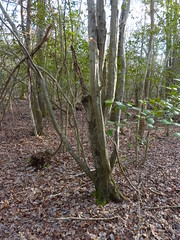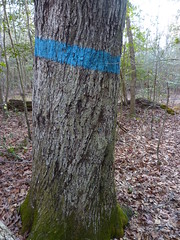 Throughout the 19th century our farm was part of a larger quarter section called "Rennolds Quarters". In the early part of the 20th century BD's grandfather surveyed the whole thing preparatory to the owners selling it off as farms. He picked the nicest farm land for himself and gave it to his daughter as a dowry. At the time, though, the entire place was open cropland except for a small piece of timber on the southern end. That was divided into 4 pieces so that each new landowner would have a woodlot. This is ours and we call it White Oak Swamp. It was cut in 1988 and we used the proceeds to finish the house - especially the kitchen, which was still just bare studs and plumbing! Somewhere there's a photograph of me washing dishes in that kitchen against that awful background. It was the catalyst that pushed me into insisting Something Be Done!
Throughout the 19th century our farm was part of a larger quarter section called "Rennolds Quarters". In the early part of the 20th century BD's grandfather surveyed the whole thing preparatory to the owners selling it off as farms. He picked the nicest farm land for himself and gave it to his daughter as a dowry. At the time, though, the entire place was open cropland except for a small piece of timber on the southern end. That was divided into 4 pieces so that each new landowner would have a woodlot. This is ours and we call it White Oak Swamp. It was cut in 1988 and we used the proceeds to finish the house - especially the kitchen, which was still just bare studs and plumbing! Somewhere there's a photograph of me washing dishes in that kitchen against that awful background. It was the catalyst that pushed me into insisting Something Be Done! When it came time to reseed the forest, BD couldn't bear to put in More Loblolly Pines. Instead, he planted cypress trees because, after all, it's White Oak Swamp, not White Oak Fields or Meadow or whatever. It's grown up over the past 22 years into something of a bramble and certainly a marvelous stand of cypress trees. But so much greenbrier crowds this place that walking here is not much fun. Or at least, it hasn't been till recently. This year we rented the piece out to 4 of the nicest hunters and boy have they opened this place up!
When it came time to reseed the forest, BD couldn't bear to put in More Loblolly Pines. Instead, he planted cypress trees because, after all, it's White Oak Swamp, not White Oak Fields or Meadow or whatever. It's grown up over the past 22 years into something of a bramble and certainly a marvelous stand of cypress trees. But so much greenbrier crowds this place that walking here is not much fun. Or at least, it hasn't been till recently. This year we rented the piece out to 4 of the nicest hunters and boy have they opened this place up! I've known they were transforming it, but I had no idea it had been turned into a national park! Here are Socks and Jack showing me how much more fun it is to walk through here now.
I've known they were transforming it, but I had no idea it had been turned into a national park! Here are Socks and Jack showing me how much more fun it is to walk through here now. This ain't called a swamp for nothin'! We had one of the worst droughts in decades summer of 2010 and it hasn't rained all that much during the fall and winter either but there's still plenty of water standing around - perfect for cypress trees and for reflecting the sky with its still surface.
This ain't called a swamp for nothin'! We had one of the worst droughts in decades summer of 2010 and it hasn't rained all that much during the fall and winter either but there's still plenty of water standing around - perfect for cypress trees and for reflecting the sky with its still surface.
 One of the things I love about these wild tangled woods are the tree sculptures you stumble upon walking about. Here, the muscular hornbeam thrusts it's sinewy arms up to the sky. each trunk and most of the branches of this tree looks like it's strung with tendons, arching, straining upward. They're the Kali of the Virginia forests.
One of the things I love about these wild tangled woods are the tree sculptures you stumble upon walking about. Here, the muscular hornbeam thrusts it's sinewy arms up to the sky. each trunk and most of the branches of this tree looks like it's strung with tendons, arching, straining upward. They're the Kali of the Virginia forests. I was struck with the flowing curves of this tree's bark but what you can't see is the squirrel up there, chittering down at those pesky dogs. He knew he was safe from them. He just didn't like having to deal with their rough intrusions.
I was struck with the flowing curves of this tree's bark but what you can't see is the squirrel up there, chittering down at those pesky dogs. He knew he was safe from them. He just didn't like having to deal with their rough intrusions.How's this for some twisted sculpture? Two views of this what? Cherry tree? Ack! Now I am embarrassed I can't remember what it was and I don't know the bark well enough to feel confident.
 From this side that bottom loop looks like it's grown back into the trunk. It hasn't of course, but it could fool you if you came to it from this direction.
From this side that bottom loop looks like it's grown back into the trunk. It hasn't of course, but it could fool you if you came to it from this direction.  Now here is something really special. This is a line tree - and it's been marked by three generations of my guys. The blue line was painted by LD - who used to have a boundary marking service when he lived here in VA. if you look down from that blue line along the left side of the tree you see three dark slashes. They were put in by BD when he was a land surveyor and marked the property just before we had the timber cut in 1988. The deep gash you see on the bottom right, just up from the base of the tree was put there by B.J.Saunders in 1913 when he did the original survey that broke up Rennolds Quarters.
Now here is something really special. This is a line tree - and it's been marked by three generations of my guys. The blue line was painted by LD - who used to have a boundary marking service when he lived here in VA. if you look down from that blue line along the left side of the tree you see three dark slashes. They were put in by BD when he was a land surveyor and marked the property just before we had the timber cut in 1988. The deep gash you see on the bottom right, just up from the base of the tree was put there by B.J.Saunders in 1913 when he did the original survey that broke up Rennolds Quarters. Proof that life is a circle - here is a young holly tree sprouted inside the stump of a dead oak.

Priss says that it's never too cold to take a dip ... if you have the right kind of fur.


pris and the ducks agree bess!
ReplyDeleteThank you, Bess, for the wonderful walk in your woods today!
ReplyDeleteFascinating. IIRC, Virginia was originally surveyed (I mean, like back in the 1700s) using metes-and-bounds rather than the more rectilinear method that much of the rest of the country had.
ReplyDeleteI've seen some of the old PLS (Public Land Survey) information; a lot of plant ecologists use the survey data to reconstruct what the forests were like pre-European settlement, because the surveyors made note of what tree species they were marking - so it was almost like doing sampling of the trees, without it actually being that!
I'd love to see those woods someday. We have a lot of greenbriar around here, too.